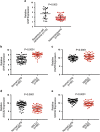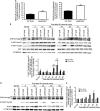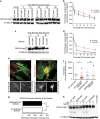A growth hormone receptor SNP promotes lung cancer by impairment of SOCS2-mediated degradation
- PMID: 28967904
- PMCID: PMC5799715
- DOI: 10.1038/onc.2017.352
A growth hormone receptor SNP promotes lung cancer by impairment of SOCS2-mediated degradation
Abstract
Both humans and mice lacking functional growth hormone (GH) receptors are known to be resistant to cancer. Further, autocrine GH has been reported to act as a cancer promoter. Here we present the first example of a variant of the GH receptor (GHR) associated with cancer promotion, in this case lung cancer. We show that the GHRP495T variant located in the receptor intracellular domain is able to prolong the GH signal in vitro using stably expressing mouse pro-B-cell and human lung cell lines. This is relevant because GH secretion is pulsatile, and extending the signal duration makes it resemble autocrine GH action. Signal duration for the activated GHR is primarily controlled by suppressor of cytokine signalling 2 (SOCS2), the substrate recognition component of the E3 protein ligase responsible for ubiquitinylation and degradation of the GHR. SOCS2 is induced by a GH pulse and we show that SOCS2 binding to the GHR is impaired by a threonine substitution at Pro 495. This results in decreased internalisation and degradation of the receptor evident in TIRF microscopy and by measurement of mature (surface) receptor expression. Mutational analysis showed that the residue at position 495 impairs SOCS2 binding only when a threonine is present, consistent with interference with the adjacent Thr494. The latter is key for SOCS2 binding, together with nearby Tyr487, which must be phosphorylated for SOCS2 binding. We also undertook nuclear magnetic resonance spectroscopy approach for structural comparison of the SOCS2 binding scaffold Ile455-Ser588, and concluded that this single substitution has altered the structure of the SOCS2 binding site. Importantly, we find that lung BEAS-2B cells expressing GHRP495T display increased expression of transcripts associated with tumour proliferation, epithelial-mesenchymal transition and metastases (TWIST1, SNAI2, EGFR, MYC and CCND1) at 2 h after a GH pulse. This is consistent with prolonged GH signalling acting to promote cancer progression in lung cancer.
Conflict of interest statement
The authors declare no conflict of interest.
Figures







References
-
- Chhabra Y, Waters MJ, Brooks AJ. Role of the growth hormone–IGF-1 axis in cancer. Exp Rev Endocrinol Metab 2011; 6: 71–84. - PubMed
-
- Stajduhar E, Sedic M, Lenicek T, Radulovic P, Kerenji A, Kruslin B et al. Expression of growth hormone receptor, plakoglobin and NEDD9 protein in association with tumour progression and metastasis in human breast cancer. Tumour Biol 2014; 35: 6425–6434. - PubMed
-
- Yu H, Spitz MR, Mistry J, Gu J, Hong WK, Wu X. Plasma levels of insulin-like growth factor-I and lung cancer risk: a case-control analysis. J Natl Cancer Inst 1999; 91: 151–156. - PubMed
-
- Gunnell D, Okasha M, Smith GD, Oliver SE, Sandhu J, Holly JM. Height, leg length, and cancer risk: a systematic review. Epidemiol Rev 2001; 23: 313–342. - PubMed
Publication types
MeSH terms
Substances
LinkOut - more resources
Full Text Sources
Other Literature Sources
Medical
Research Materials
Miscellaneous

